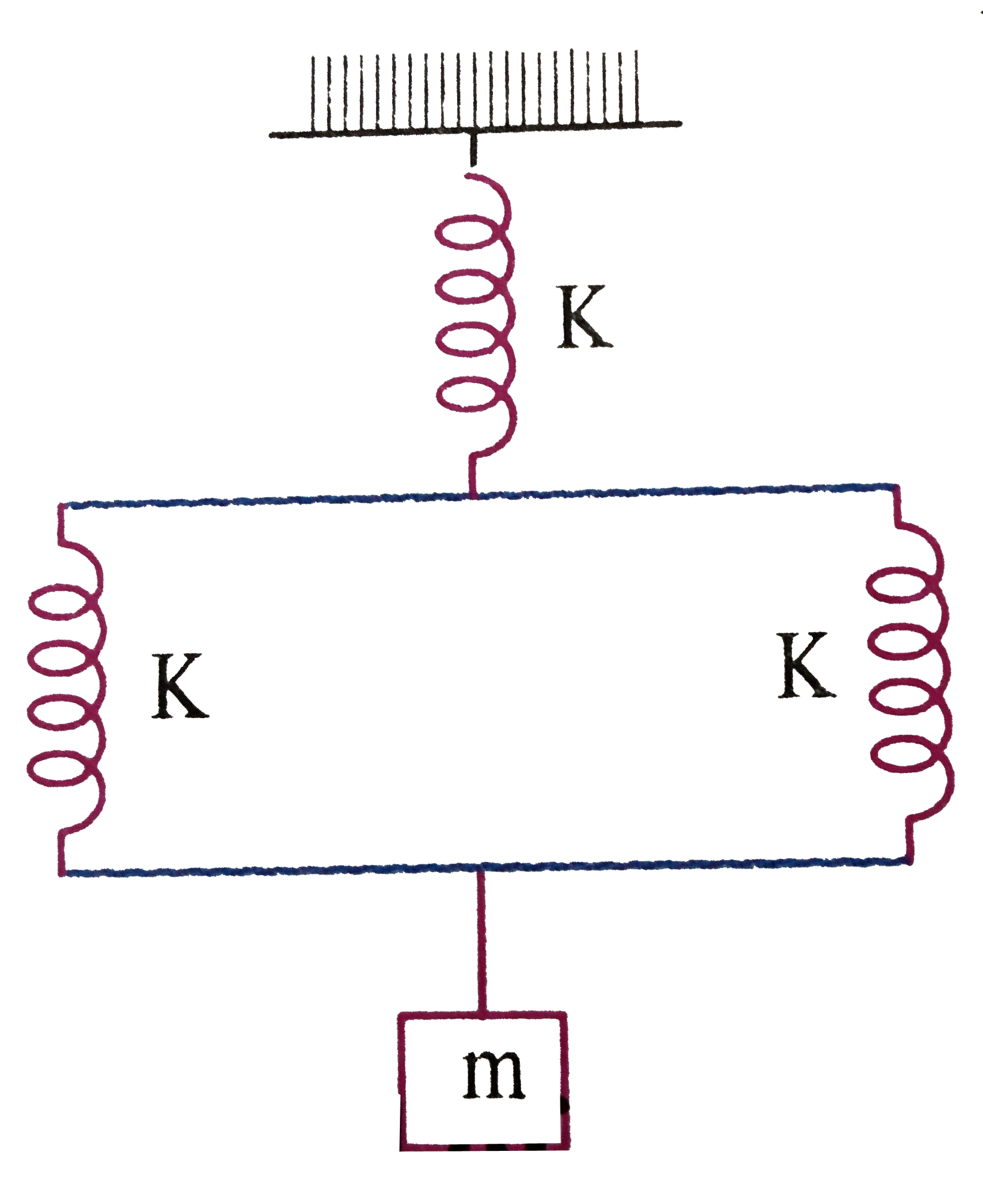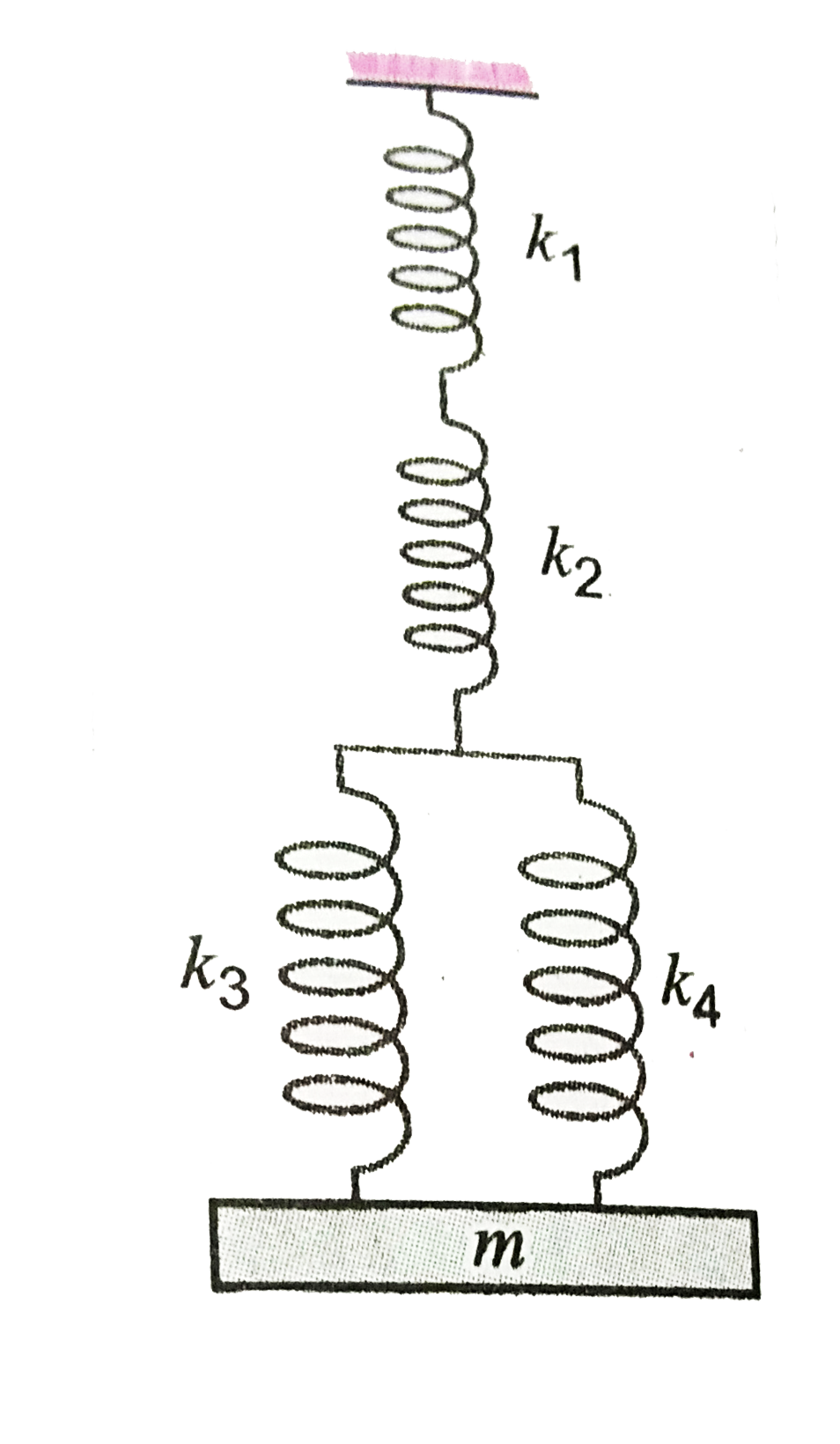A weightless spring has a force constant k oscillates with frequency f when a mass m is suspended from it The spring is cut into three equal parts and a mass 3 m is suspended from it The frequency of oscillation of one part will now become
f
2 f
f / 3
3 f
The correct Answer is:A
To solve the problem, we need to analyze the situation step by step.
Step 1: Understand the initial conditions
The initial frequency f of the spring with a mass m is given by the formula:
f=12π√km
where k is the spring constant.
Hint: Remember that the frequency of oscillation depends on both the mass attached and the spring constant.
Step 2: Analyze the effect of cutting the spring
When the spring is cut into three equal parts, the length of each part becomes L3 (where L is the original length of the spring). The spring constant k′ of each part is related to the original spring constant k by the formula:
k′=3k
This is because the spring constant is inversely proportional to the length of the spring.
Hint: Cutting a spring into shorter lengths increases the spring constant.
Step 3: Determine the new mass
Now, a mass of 3m is suspended from one of the cut parts of the spring.
Hint: Note how the mass has changed from m to 3m.
Step 4: Calculate the new frequency
The new frequency f′ can be calculated using the new spring constant k′=3k and the new mass m′=3m:
f′=12π√k′m′=12π√3k3m=12π√km=f
Hint: The new frequency simplifies to the original frequency because the factors of 3 cancel out.
Conclusion
Thus, the frequency of oscillation of one part of the spring with mass 3m becomes:
f′=f
Final Answer: The frequency remains the same, f.
The initial frequency f of the spring with a mass m is given by the formula:
f=12π√km
where k is the spring constant.
When the spring is cut into three equal parts, the length of each part becomes L3 (where L is the original length of the spring). The spring constant k′ of each part is related to the original spring constant k by the formula:
k′=3k
This is because the spring constant is inversely proportional to the length of the spring.
Now, a mass of 3m is suspended from one of the cut parts of the spring.
The new frequency f′ can be calculated using the new spring constant k′=3k and the new mass m′=3m:
f′=12π√k′m′=12π√3k3m=12π√km=f
Thus, the frequency of oscillation of one part of the spring with mass 3m becomes:
f′=f
Topper's Solved these Questions
Similar Questions
The time period of a mass suspended from a spring is T. If the spring is cut into four equal parts and the same mass is suspended from one of the parts, then the new time period will be
View SolutionA body of mass m is suspended from three springs as shown in figure. If mass m is displaced slightly then time period of oscillation is

View Solution
Knowledge Check
A spring has force constant K and a mass m is suspended from it. The spring is cut in half and the same is suspended from one of the havles. IF the frequency of osicllation in the frst case is α, then the frequency in the second case will be
A2 aBaCa/2Dα/√2A system of springs with their spring constants are as shown in figure. What is the frequency of oscillations of the mass m ?
 A12π√k1k2(k3+k4)[(k1+k2)+(k3+k4)+k1k4]mB12π√k1k2(k3+k4)[(k1+k2)+(k3+k4)+k1k2]mC12π√k1k2(k3+k4)[(k1+k2)+(k3+k4)+k1k2]mD12π√(k1+k2)(k3+k4)+k1k2k1k2(k3+k4)m
A12π√k1k2(k3+k4)[(k1+k2)+(k3+k4)+k1k4]mB12π√k1k2(k3+k4)[(k1+k2)+(k3+k4)+k1k2]mC12π√k1k2(k3+k4)[(k1+k2)+(k3+k4)+k1k2]mD12π√(k1+k2)(k3+k4)+k1k2k1k2(k3+k4)m
A mass m is suspended from a spring. Its frequency of oscillation is f. The spring is cut into two halves and the same mass is suspended from one of the pieces of the spring. The frequency of oscillation of the mass will be
View SolutionA block of mass M suspended from a spring oscillates with time period T. If spring is cut in to two equal parts and same mass M is suspended from one part, new period os oscillation is
View SolutionA block of mass M suspended from a spring oscillates with time period T. If spring is cut in to two equal parts and same mass M is suspended from one part, new period os oscillation is
View SolutionA mass m is suspended from a spring of force constant k. The period of oscillation is T0 The spring is cut into 4 equal parts: The same mass m is suspended from one of the parts. What is the new period?
View SolutionA object of mass m is suspended from a spring and it executes SHM with frequency n. If the mass is increased 4 times , the new frequency will be
View SolutionThe period of oscillation of mass M suspended from a spring of negligible mass is T. If along with it another mass M is also suspended, the period of oscillation will now be
View Solution
